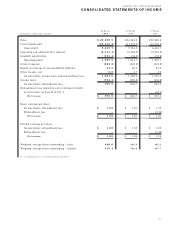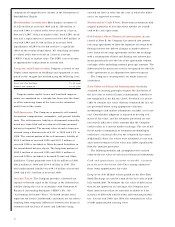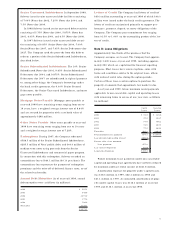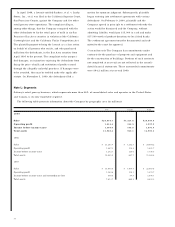Safeway 1999 Annual Report Download - page 30
Download and view the complete annual report
Please find page 30 of the 1999 Safeway annual report below. You can navigate through the pages in the report by either clicking on the pages listed below, or by using the keyword search tool below to find specific information within the annual report.
28
component of comprehensive income in the Statements of
Stockholders’ Equity.
Merchandise Inventories Merchandise inventory of
$1,823 million at year-end 1999 and $1,326 million at
year-end 1998 is valued at the lower of cost on a last-in,
first-out (“LIFO”) basis or market value. Such LIFO inven-
tory had a replacement or current cost of $1,905 million at
year-end 1999 and $1,406 million at year-end 1998.
Liquidations of LIFO layers did not have a significant
effect on the results of operations. All remaining inventory
is valued at the lower of cost on a first-in, first-out
(“FIFO”) basis or market value. The FIFO cost of invento-
ry approximates replacement or current cost.
Property and Depreciation Property is stated at cost.
Depreciation expense on buildings and equipment is com-
puted on the straight-line method using the following lives:
Stores and other buildings 7 to 40 years
Fixtures and equipment 3 to 15 years
Property under capital leases and leasehold improve-
ments are amortized on a straight-line basis over the short-
er of the remaining terms of the lease or the estimated
useful lives of the assets.
Self-Insurance The Company is primarily self-insured
for workers’ compensation, automobile, and general liability
costs. The self-insurance liability is determined actuarially,
based on claims filed and an estimate of claims incurred
but not yet reported. The present value of such claims was
accrued using a discount rate of 6.0% in 1999 and 5.5% in
1998. The current portion of the self-insurance liability of
$103.2 million at year-end 1999 and $107.3 million at
year-end 1998 is included in Other Accrued Liabilities in
the consolidated balance sheets. The long-term portion of
$243.2 million at year-end 1999 and $265.5 million at
year-end 1998 is included in Accrued Claims and Other
Liabilities. Claims payments were $123.6 million in 1999,
$98.2 million in 1998 and $100.0 million in 1997. The
total undiscounted liability was $391.9 million at year-end
1999 and $413.1 million at year-end 1998.
Income Taxes The Company provides a deferred tax
expense or benefit equal to the change in the deferred tax
liability during the year in accordance with Statement of
Financial Accounting Standards (“SFAS”) No. 109,
“Accounting for Income Taxes.” Deferred income taxes
represent tax credit carryforwards and future net tax effects
resulting from temporary differences between the financial
statement and tax basis of assets and liabilities using
enacted tax rates in effect for the year in which the differ-
ences are expected to reverse.
Statement of Cash Flows Short-term investments with
original maturities of less than three months are consid-
ered to be cash equivalents.
Off-Balance Sheet Financial Instruments As dis-
cussed in Note E, the Company has entered into interest
rate swap agreements to limit the exposure of certain of its
floating interest rate debt to changes in market interest
rates. Interest rate swap agreements involve the exchange
with a counterparty of fixed and floating rate interest pay-
ments periodically over the life of the agreements without
exchange of the underlying notional principal amounts. The
differential to be paid or received is recognized over the life
of the agreements as an adjustment to interest expense.
The Company’s counterparties are major financial
institutions.
Fair Value of Financial Instruments Generally
accepted accounting principles require the disclosure of
the fair value of certain financial instruments, whether or
not recognized in the balance sheet, for which it is practi-
cable to estimate fair value. Safeway estimated the fair val-
ues presented below using appropriate valuation
methodologies and market information available as of year-
end. Considerable judgment is required to develop esti-
mates of fair value, and the estimates presented are not
necessarily indicative of the amounts that the Company
could realize in a current market exchange. The use of dif-
ferent market assumptions or estimation methodologies
could have a material effect on the estimated fair values.
Additionally, these fair values were estimated at year-end,
and current estimates of fair value may differ significantly
from the amounts presented.
The following methods and assumptions were used to
estimate the fair value of each class of financial instruments:
Cash and equivalents, accounts receivable, accounts
payable and short-term debt The carrying amount of
these items approximates fair value.
Long-term debt Market values quoted on the New York
Stock Exchange are used to estimate the fair value of pub-
licly traded debt. To estimate the fair value of debt issues
that are not quoted on an exchange, the Company uses
those interest rates that are currently available to it for
issuance of debt with similar terms and remaining maturi-
ties. At year-end 1999 and 1998, the estimated fair value
of debt approximated carrying value.
























